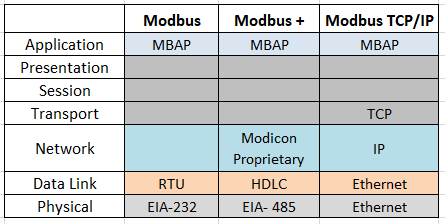In the realm of industrial automation and communication, Modbus TCP is a term that often surfaces. But what is Modbus TCP, and why is it crucial in today’s industrial landscape? This comprehensive guide will demystify Modbus TCP, providing you with insights into its origins, functions, applications, and much more. So, let’s dive right in!

In this blog, we will delve into the world of Modbus protocol (i.e. Modbus TCP IP and other variant), exploring its history, architecture, and applications, as well as understanding why it remains relevant in the 21st century.
Table of Contents
ToggleOrigins and Evolution of Modbus TCP/IP Protocol
Modbus was created by Modicon (now Schneider Electric) in 1979, primarily for use in their programmable logic controllers (PLCs). Its name is derived from “Modicon” and “bus,” signifying its role as a communication protocol for industrial devices connected on a common bus or network. Originally designed for serial communication over RS-232, RS-485, and RS-422 interfaces, Modbus has since evolved to support various other communication methods, including Ethernet and TCP/IP.
The Modbus TCP/IP protocol functions as an application layer messaging protocol that, in conjunction with Ethernet, facilitates client/server communication between devices linked across various types of networks.
Renowned for its emphasis on simplicity and resilience, this protocol has garnered widespread adoption. Its popularity is attributed to its user-friendly nature, open standards, and capacity to seamlessly integrate an array of devices into a network. Consequently, Modbus TCP/IP emerges as the protocol of choice for numerous applications.
Basic Fundamental of Modbus TCP/IP
Modbus TCP/IP is a widely used communication protocol in the realm of industrial automation and control systems. Its fundamental principles revolve around facilitating seamless data exchange and communication between various devices and components within an industrial network.
Modbus TCP/IP Overview
Modbus TCP/IP represents an adaptation of the Modbus protocol tailored for use within TCP/IP networks. It serves as a standardized gateway for Modbus devices, enabling them to seamlessly communicate over Ethernet, thereby facilitating efficient data exchange. Its primary objective revolves around bridging Modbus communication within Ethernet-based systems, ensuring compatibility with contemporary interconnected networks.
This messaging protocol inherits the user-friendly and robust characteristics of the original Modbus while incorporating the reliability and interoperability inherent to TCP/IP. It encapsulates Modbus data within TCP/IP packets, simplifying data transport across standard network infrastructures.
Modbus TCP/IP relies on TCP as its transport protocol, guaranteeing reliable and orderly message delivery through features like data segmentation, acknowledgment, and retransmission. It leans on IP for tasks such as addressing, routing, and packet delivery, relying on IP addresses to identify devices within a network.
Functioning within a client-server framework, one device assumes the role of the client, initiating requests, while others operate as servers, handling these requests and furnishing responses. This operational model positions Modbus TCP/IP as an elegant solution for contemporary network infrastructures, underscoring its significance in today’s digital industrial landscape.
Fundamental features of Modbus TCP/IP
The Modbus protocol family, which encompasses Modbus TCP/IP, is grounded in a set of core principles and concepts that lay the groundwork for its functionality. These foundational elements are outlined as follows:
Client/Server Architecture:
At its core, Modbus TCP/IP operates on a client/server architecture. This means that within the network, there are devices known as clients that request information or perform actions, and there are servers that respond to these requests and provide the requested data or execute commands.
Open Standard:
Modbus TCP/IP is an open standard, ensuring compatibility and interoperability between devices and equipment from different manufacturers. This open nature promotes flexibility in designing and implementing industrial systems.
Ethernet Connectivity:
Unlike its predecessor, Modbus RTU, which used serial communication, Modbus TCP/IP utilizes Ethernet as its underlying transport layer. This transition to Ethernet makes it suitable for modern industrial networks and allows for communication over longer distances.
Data holding registers:
In a Modbus system, data is organized and interpreted through four fundamental data entities: Discrete Inputs, Coils, Input Registers, and Holding Registers. These entities play a crucial role in managing and making sense of data within the Modbus framework.
Function Codes for Read/Write Operations:
Data access within the Modbus protocol is determined by the function code field within the Modbus data frame. These function codes are pivotal as they define the specific action to be executed on a data entity. These actions encompass a wide array, from simple reading and writing to more complex data manipulation functions.
Addressing Method:
Modbus utilizes a straightforward addressing scheme that relies on numerical values to identify the registers being accessed. This scheme specifies both the starting register address and the number of registers to be read or written.
Architecture of Modbus TCP/IP Protocol
Modbus operates on a simple master-slave architecture, where a single master device communicates with one or more slave devices. The master is typically a supervisory control and data acquisition (SCADA) system, a PLC, or any other controller that initiates and manages communication. The slaves consist of sensors, actuators, meters, and other devices that respond to the master’s requests.
The Foundation: TCP/IP Stack
At the core of Modbus TCP/IP Architecture lies the TCP/IP stack, a multifaceted structure responsible for smooth network communication.
Here in this image you will find stack layers with three variants of Modbus Protocol.

This stack consists of three vital layers:
Physical Layer (Ethernet)
The journey begins with the physical layer, where Ethernet connections are established. This layer ensures the physical transmission of data across the network, creating a stable foundation for communication.
Network Layer (IP)
Moving up the stack, we encounter the network layer, which operates using Internet Protocol (IP). Here, data is routed across the network, enabling devices to locate and communicate with each other.
Transport Layer (TCP)
The transport layer, perched atop the stack, plays a pivotal role in data transmission. Using the Transmission Control Protocol (TCP), this layer manages the orderly and error-checked delivery of information across the network.
The Enigmatic MBAP
Above the TCP/IP stack, within the application layer, resides the Modbus Application Protocol (MBAP). This enigmatic component encapsulates Modbus messages within TCP/IP packets, facilitating seamless communication across standard network infrastructure.
Modbus Data Representation
Modbus protocol deals with discrete and analog data types. Discrete data represents binary information (e.g., ON/OFF), while analog data represents continuous values (e.g., temperature or pressure readings). The protocol defines different function codes for reading and writing discrete and analog data, ensuring efficient and accurate data exchange.
Modbus Modes of Operation
There are two primary modes of Modbus operation: Modbus RTU (Remote Terminal Unit) and Modbus TCP/IP.
Modbus RTU: In this mode, data is transmitted in binary format and is well-suited for serial communication, making it popular for legacy devices and applications.
Modbus TCP / IP: This mode, based on the TCP/IP protocol, allows data transmission over Ethernet networks. Modbus TCP/IP has gained prominence with the increasing prevalence of Ethernet in industrial automation.
Advantages of Modbus TCP Protocol
Open Protocol: Modbus is an open protocol, meaning its specifications are freely available, fostering interoperability among different vendors’ devices.
Simplicity: The protocol’s simplicity allows for easy implementation, debugging, and integration with various industrial devices.
Versatility: Modbus supports both serial and Ethernet communication, offering flexibility in connecting devices across various architectures.
Time-Tested: Having been in existence for decades, Modbus has proven its reliability and stability in industrial applications.
Applications of Modbus TCP Protocol
Industrial Automation: It enables communication between PLCs, sensors, and actuators, facilitating process control and monitoring.
Energy Management: Modbus allows integration of energy meters, enabling efficient energy consumption monitoring and analysis.
Building Automation: Modbus is used to connect and control HVAC systems, lighting, security systems, and more in modern buildings.
Renewable Energy: In solar and wind power plants, Modbus is utilized for data acquisition and control purposes.
The Future of Modbus Protocol
In recent years, as industrial communication standards evolve, some may wonder about the future of Modbus. Despite being a mature protocol, Modbus remains highly relevant and widely adopted in various industries. Its simplicity, openness, and ease of use continue to appeal to manufacturers, system integrators, and developers. Moreover, many existing installations continue to rely on Modbus, ensuring its continued presence in industrial settings for years to come.
Conclusion
The Modbus protocol has undoubtedly left a significant impact on the industrial landscape. From its humble beginnings in the late 1970s, it has grown into a universal language for industrial communication, fostering seamless data exchange and interoperability among diverse devices. Its simplicity, versatility, and time-tested reliability have ensured its sustained relevance in the 21st century. As industries continue to embrace digital transformation, Modbus will likely continue to play a vital role, connecting devices and driving industrial automation forward.
If you want to watch video on Modbus in Hindi watch this video.
Frequently Asked Questions (FAQs) for Interviews
Question 1: What is the Modbus protocol, and what is its primary purpose in the field of industrial automation?
Answer: The Modbus protocol is a widely used communication protocol in the industrial automation and control systems domain. Its primary purpose is to enable communication between various devices such as PLCs (Programmable Logic Controllers), sensors, and HMIs (Human Machine Interfaces) in industrial settings. It allows these devices to exchange data and control information, facilitating the monitoring and control of industrial processes.
Question 2: Explain the key differences between Modbus RTU and Modbus TCP. When would you choose one over the other in an industrial setting?
Answer: Modbus RTU and Modbus TCP are two variants of the Modbus protocol. Modbus RTU uses a serial communication format, while Modbus TCP utilizes Ethernet. The key difference is in the physical layer. Modbus RTU is suitable for legacy systems and shorter-distance communication, whereas Modbus TCP is preferred for modern Ethernet-based networks, offering faster communication over longer distances.
Question 3: Can you describe the basic structure of a Modbus message frame? What are the essential elements within this frame?
Answer: A Modbus message frame consists of several key elements:
Address: Specifies the device’s address on the network.
Function Code: Determines the type of operation to be performed.
Data: Contains the information to be transmitted, which varies based on the function code.
Error Checking: Includes a CRC or LRC (Cyclic Redundancy Check or Longitudinal Redundancy Check) for data integrity.
Start and Stop Bits: Used in serial communication to mark the beginning and end of a frame.
Question 4: What are the typical data types used in Modbus registers, and how are they represented in Modbus communication?
Answer: Modbus supports various data types, including:
Coils: Represent discrete values (ON/OFF, 1/0).
Holding Registers: Store 16-bit binary data.
Input Registers: Read-only registers for 16-bit binary data.
Input Status (Discrete Inputs): Represent discrete input values (e.g., sensor states).
Data in these registers is typically represented as binary values or integers, and they can be read or written to by Modbus devices.
Question 5: How does error checking and correction work in Modbus communication? What mechanisms are in place to ensure data integrity?
Answer: Modbus uses CRC or LRC checksums to ensure data integrity. When data is transmitted, a checksum is calculated based on the message content. The receiving device also calculates a checksum upon receipt and compares it to the transmitted checksum. If they match, the data is considered intact. If not, the data is retransmitted.
Question 6: In Modbus communication, what is a “Function Code,” and how is it used to control the operation of devices on the network?
Answer: The Function Code in a Modbus message frame defines the type of operation to be performed. For example, Function Code 3 is used to read Analog Output Holding Registers, while Function Code 6 is used to write a single value to an Analog Output Holding Register. Function Codes serve as commands that instruct devices on what action to take in response to a Modbus request.
Question 7: Explain the concept of Modbus “master” and “slave” devices. What roles do they play in a Modbus network, and how do they communicate?
Answer: In a Modbus network, a “master” device initiates communication by sending requests to “slave” devices. Masters typically control the network and collect data, while slaves respond to requests and provide data. Slaves don’t communicate directly with each other. They communicate via function codes sent by the master. For example, a master might request data from a temperature sensor (slave) using Function Code 4 (Read Input Registers), and the slave responds with the requested data.
Question 8: What is the significance of the Modbus “coil” and “holding register” data types? How are they utilized in industrial applications?
Answer: Coils and holding registers are fundamental Modbus data types:
Coils: They represent discrete outputs and are often used to control devices (e.g., turning a motor on/off). Coils are writable.
Holding Registers: These are used for storing data like setpoints or configuration values. They are both readable and writable.
Coils and holding registers provide a means to control and monitor industrial processes efficiently.
Question 9: Can you discuss the limitations and constraints of the Modbus protocol, especially when it comes to scalability and security in modern industrial systems?
Answer: Modbus has limitations, including:
Scalability: It can be challenging to scale Modbus networks due to addressing constraints, and it may not handle large numbers of devices efficiently.
Security: Modbus was designed in an era when security wasn’t a primary concern. It lacks robust security features, making it vulnerable to unauthorized access or data interception.
Modern industrial systems often require additional security measures and more scalable protocols alongside Modbus to meet evolving needs.
Question 10: In a scenario where you encounter communication issues in a Modbus network, what troubleshooting steps would you take to diagnose and resolve the problem?
Answer: Troubleshooting Modbus communication issues involves several steps:
- Physical Check: Inspect physical connections, cables, and device power.
- Addressing: Ensure each device has a unique address on the network.
- Function Codes: Verify that the correct function codes are being used.
- Checksums: Check for CRC or LRC errors in received data frames.
- Network Traffic: Monitor network traffic for collisions or excessive noise.
- Firewall and Security: Ensure that firewalls and security settings permit Modbus traffic.
- Device Configuration: Review device settings and configurations for errors.
- Logs and Diagnostics: Utilize device logs and diagnostic tools for further analysis.
Question 11: What are some best practices for optimizing Modbus communication in terms of speed and reliability, especially in large-scale industrial environments?
Answer: To optimize Modbus communication:
- Minimize Network Load: Reduce unnecessary polling and minimize broadcast traffic.
- Use Proper Addressing: Organize addresses logically and efficiently.
- Error Handling: Implement robust error handling and retransmission mechanisms.
- Network Segmentation: Divide the network into segments to isolate issues.
- Timing and Delays: Adjust timeouts and delays to suit the network’s characteristics.
- Upgrade to Modbus TCP: Consider transitioning to Modbus TCP for improved speed and reliability in Ethernet-based networks.
These practices can enhance the speed and reliability of Modbus communication in industrial environments.
Question 12: As the landscape of industrial automation evolves, what future developments or enhancements do you foresee for the Modbus protocol to remain relevant and secure?
Answer: To ensure Modbus remains relevant and secure, future developments may include:
Enhanced Security: Implementing modern security protocols to safeguard against cyber threats.
Extended Addressing: Expanding addressing capabilities for larger networks.
IoT Integration: Facilitating seamless integration with the Internet of Things (IoT) for more extensive data sharing.
Higher Throughput: Improving data transfer rates to meet the demands of modern industrial processes.
Standardization: Collaborating with industry bodies to maintain compatibility and standardization.
These advancements will help Modbus adapt to the evolving industrial landscape while ensuring security and compatibility.

